-
 16 min. read
16 min. read
-
 WebFX Team
WebFX Team Digital Marketing Agency
Digital Marketing Agency
- The WebFX team is made up of more than 450 subject matter experts in digital marketing, SEO, web design and web development, social media, and more. Together, they’ve helped WebFX’s clients earn more than $3 billion in revenue from the web — and that’s just in the past five years. @webfx
As a marketing manager, you know that you have your own leadership style — just like every other leader in history. There are eight main leadership styles in the world, and they all have their pros and cons.
In today’s world, you can find success (and failure) stories about any kind of leader. Whether they were political, financial, philosophical, or managerial, each of these leaders has his or her style.
That’s not to say one is better than the other — it all depends on what you want to accomplish. With that in mind, do you know what your leadership style is? Are you the iron-fisted autocratic leader?
The hear-everyone’s-thoughts democratic leader?
Or maybe the humble servant leader? This infographic gives you all the information you need to know where you fall, plus some inspiring quotes from some of history’s most noteworthy leaders. With it, you can finally answer that burning question: What’s your leadership style?

Style #1. Autocratic leadership: The commander

The first leadership style is one of the most well-known in the world — autocratic. Autocratic leaders are defined by their my-way-or-the-highway mentality, which is extremely effective for accomplishing goals quickly.
The reason it works so well is that it sets a goal, establishes the methods to reach that goal, and sets people to work. There’s no room for second-guessing or questioning, and a leader’s orders efficiently travel down the chain of command.
That lets autocratic leaders accomplish their goals quickly. They thrive under that quick-moving versatility, and they seek to establish consistency and predictability.
With all of those goals, it’s easy to keep managers and workers on-task most of the time — they’ll constantly have their hands full. On the downside, full power in one person means it’s easy for that person to abuse it.
There’s not much accountability on the leader’s part, and if their only motive is profit, they’ll do anything they can to get more. Their single-minded mentality can also discourage ideas from their managers and workers, which consequently harms morale. Still, the autocratic leader can simply get things done.
This may sound familiar to any readers who are veterans since the autocratic style is used by every military (and para-military organization) throughout the world.
That’s how General George S. Patton, who led US troops through Europe and the Mediterranean in World War II, fits into this paradigm. The autocratic style also famously includes the wealthy, turn-of-the-century business magnates like John D.
Rockefeller. Rockefeller and other magnates ruled their industries like Julius Caesar ruled Rome — clear objectives, clear paths to those objectives, and the sheer force of will to rally others behind him. Granted, rallying people to your cause doesn’t take much when you have 1.5% of the United States economy in your bank account.
But everyone has to start somewhere — and Rockefeller started as a bookkeeper when he was 16. However, the biggest reason that Patton and Rockefeller thrived with this leadership style is that they worked in an industry (military, big business) and time period (major war, “Robber Baron” era) when they didn’t have to spend a ton of time thinking about abuse of power, creativity, or morale. They set high standards for military and business leadership, and they’re regarded as some of the best leaders to have existed. And they did it by running a tight ship.
Style #2. Bureaucratic leadership: The administrator
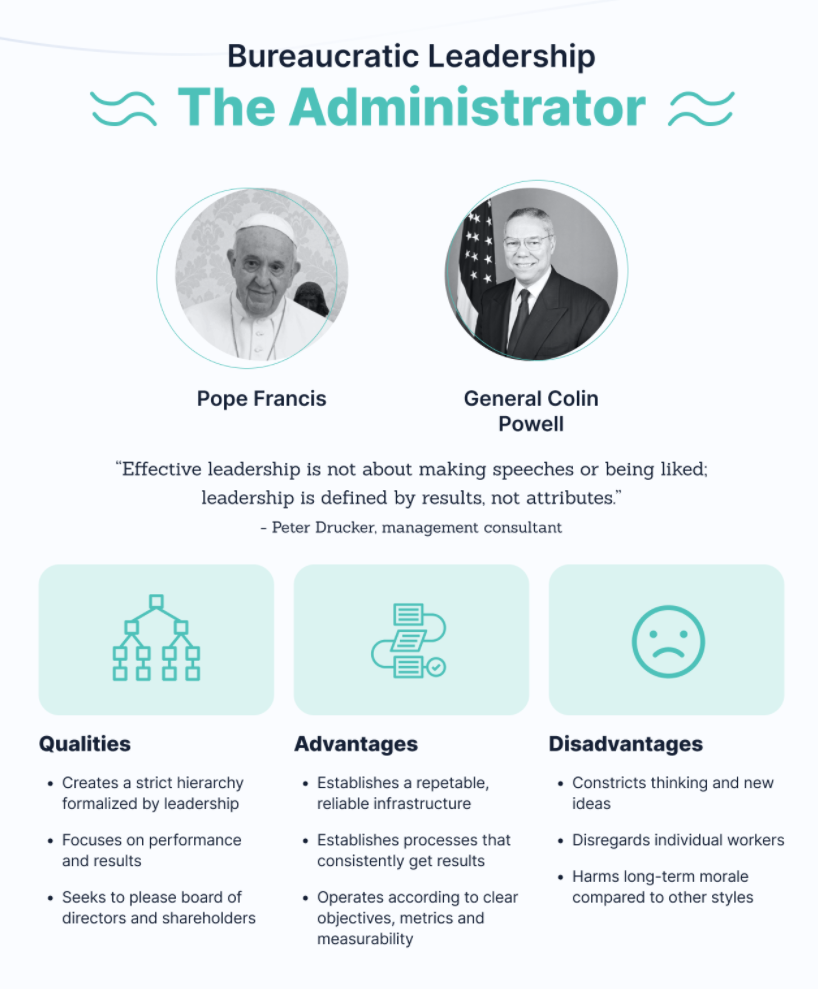
Bureaucratic leadership is also a well-known style since everyone will encounter it at some point in their lives. Bureaucratic leaders establish set systems of rules, steps, and record-keeping that must be followed in order for someone to do something. People who have to go through those steps might refer to them as “red tape.” To a bureaucratic leader, they’re called “necessities.” To help with those necessities, bureaucratic leaders establish a clear hierarchy of leaders and task-completers who focus on getting something done right — not necessarily fast.
That structure establishes a system that’s designed to repeat the same processes to get the same, consistent results.
That system often looks like a checklist and lots of forms. But, because this leadership style is so structured, it also constricts new thinking. Individual workers also don’t get a lot of credit since they’re a part of the system and bureaucratic leaders are focused on the results of that system — not the results of a person.
Over the long-term, workers can become discouraged working under a bureaucratic leader since there are little variety and wiggle room. Pope Francis is probably the best-known bureaucratic in the world. His bureaucracy is the Catholic Church, which has a set ranking system of who’s in charge, what they can do, and how they can do it.
The Church also has long lists of rules dictating how priests, bishops, cardinals, and other ranking workers can function in their role and help others. Similarly, General Colin Powell worked within one of the most extensive bureaucracies in the world — the United States federal government — as the secretary of state.
In that position, Powell was required to advise the sitting president on all foreign policy issues, and he was also responsible for delegating the orders of the president (G. W.
Bush) to the state department. That combination advisor-delegator role means Powell needed the state department to operate in a familiar, repeatable, and results-oriented way so he could see the president’s orders through to the end. This style is similar to autocratic leadership, but it differs based on its obsession with repeating the same tasks to get the same results.
Autocratic leadership can be innovative if the leader is willing to adapt.
But bureaucratic leadership relies on an extensive system, and that means innovation is a lot less common.
Style #3. Charismatic leadership: The charmer
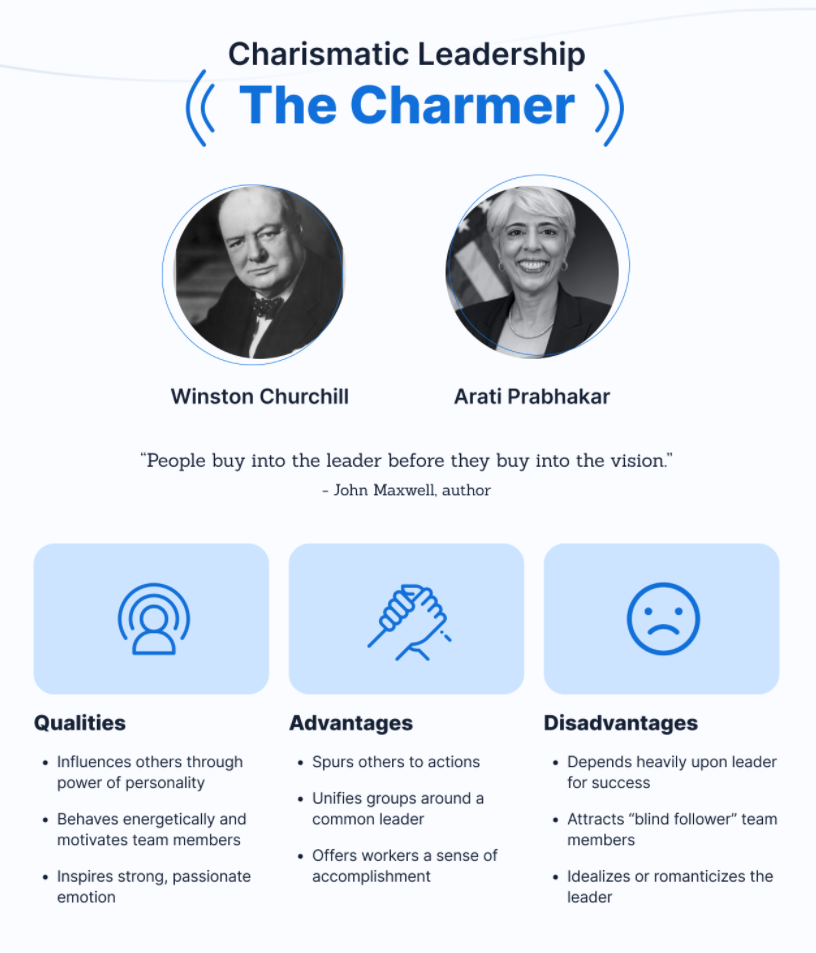
Charismatic leaders achieve power by offering themselves as part of their vision. The pure power of their personalities is influence enough to earn the loyalty and dedication of their followers, and their palpable energy keeps everyone motivated and moving forward.
The people who follow a charismatic leader are extraordinarily passionate compared to most other leadership styles. That passion has lots of advantages.
It keeps people working, unifies them around a common characteristic (the leader), and gives people a sense of accomplishment when they complete a task. On the flip side, the leader is the focus of this style, so if anything happens to them, the whole organization crumbles.
There’s also the risk of attracting “blind follower” team members, or people who like the leader but have nothing to offer. Last — and most importantly — the people around a charismatic leader tend to idealize or romanticize that leader.
That makes it hard for anyone to criticize or improve an existing structure because everyone wants to protect and achieve the leader’s vision. While some of Winston Churchill’s photos may make him look surly or unapproachable, his charisma is almost as legendary as his leadership during World War II. Churchill’s speeches have gone down in history as some of the most moving and inspiring words ever spoken.
“Humanity will not be cast down.
We are going on swinging bravely forward along the grand high road and already behind the distant mountains is the promise of the sun.”
All told, Churchill’s incredible words touched his country and helped get them through one of the most trying times in English history.
A more modern example of a charismatic leader is Arati Prabhakar, the current director of the United States Defense Advanced Research Projects Agency (DARPA). Prabhakar first headed a federal office at 34 after studying at CalTech and Texas Tech. Since then, she’s risen to the top of the government’s foremost technology departments, flexing her extensive engineering expertise and noteworthy crowd-working skills whenever she’s on camera.
Prabhakar may not have as many catchy soundbites as Churchill, but her approachability, modesty, and dedication to her occupation has led others in the defense field to note that “she’s very charismatic.”
Couple that with DARPA’s extensive research into future tech, and it’s clear that Prabhakar’s ability to work a room is not just a formality — it’s leadership.
Style #4. Democratic leadership: The motivator
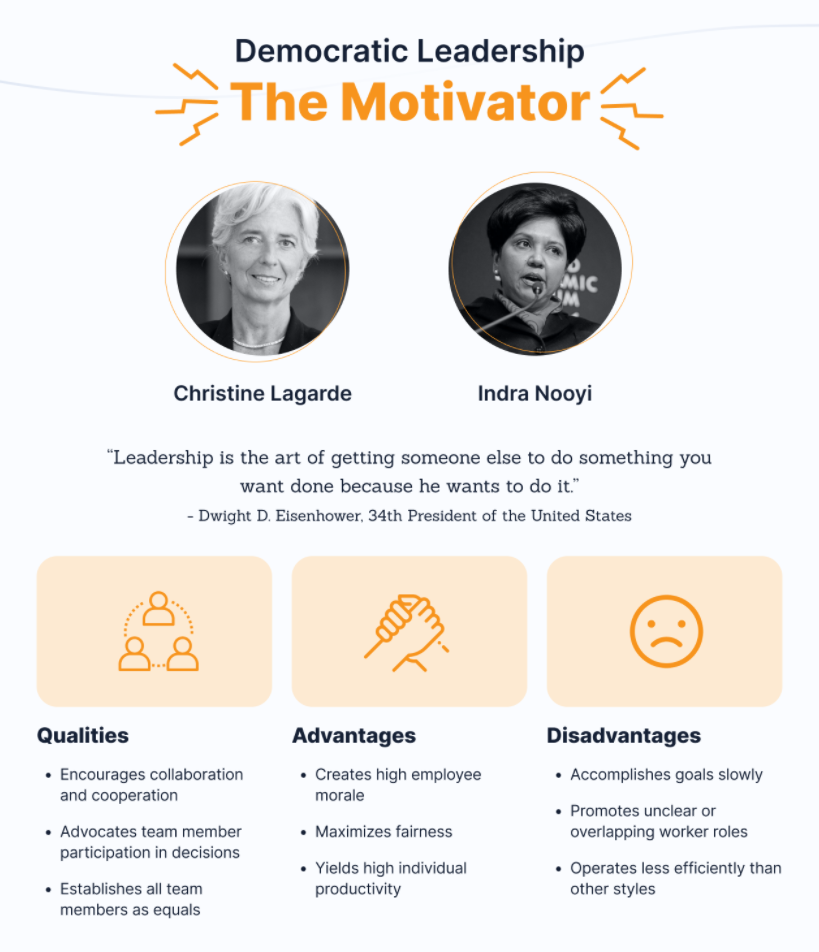
Democratic leadership reflects a leader’s interest in keeping everyone on a level playing field. Each person has a say in the direction of the company, and their input is based on merit instead of their standing. That means democratic leadership requires a lot of motivation, collaboration, and cooperation.
It advocates discussion and equal participation from all team members, and while there may be manag
ers here and there, a worker’s input is always valuable. It’s no wonder that democratic leadership often yields high employee morale as a result, which helps get outstanding results from individuals. It also maximizes fairness so people can be rewarded for going above and beyond.
On the flip side, democratic leadership is one of the slowest styles out there.
Plus, since it establishes people as equals, it can be difficult to carve out exact roles for individuals. As a result, inefficiency can be high. Christine Lagarde — the managing director of the International Monetary Fund — is one of the most public leaders to embrace the democratic style.
As she frames it, her leadership style is deeply rooted in her personal beliefs.
“To me, leadership is about encouraging people… Others would call it a ‘vision,’ but I’d rather use ‘purpose’ because I think that everybody has a purpose in life and when collectively people work together… they have a joint purpose.”
That kind of leadership is ideal for the head of the IMF, who’s in charge of helping economically-impoverished areas.
They need to make choices based on merit and urgency — not subjective qualities.
You can find another major proponent of democratic leadership in Indra Nooyi, the CEO of PepsiCo. Nooyi is attempting to maintain PepsiCo’s profitability in a society that’s increasingly health-conscious, which isn’t easy when the company’s primary product is a soft drink. But that doesn’t stop her from being ” a deeply caring person” who has even earned a reputation as “a caring CEO.”
That caring style (combined with her radical new vision for PepsiCo) keeps her open to new ideas, particularly those that have merit behind them, as opposed to a recognized boardroom favorite.
Style #5. Laissez-Faire leadership: The delegator
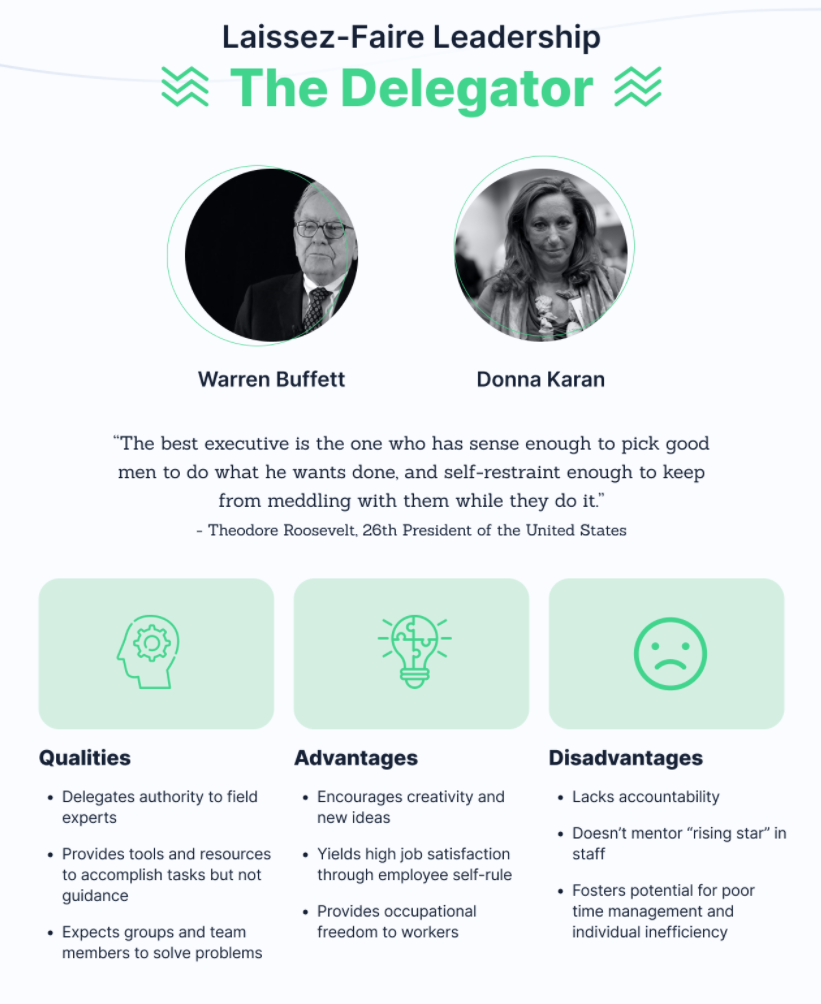
Laissez-faire leadership is based on the idea that people will do what you ask of them if you just let them do it their way. This “hands-off” approach to business is based on the same base principle of laissez-faire economics — don’t interfere. That means these leaders delegate authority to experts in their companies, giving them the tools and resources to accomplish a task, but not a checklist.
As a result, groups and team members are expected to solve problems on their own time — and in their own ways. This freedom fosters lots of creativity and new ideas, on top of job satisfaction. Workers are free to determine the best methods to solve any problem that comes their way.
But laissez-faire leadership isn’t all sunshine and roses.
There’s a huge lack of accountability on the part of the worker since no one regularly checks in on what they’re doing. It also lacks the ability to mentor “rising stars” in a company, so you could miss out on a lot of talented individuals working in upper-managerial or C-level positions. Last, there’s a huge potential for poor time management and individual inefficiency.
That’s not to say workers under this style would exploit their freedom — it just takes longer to think of new solutions than to re-use tried-and-true methods.
Warren Buffett is probably the most famous proponent of this leadership style. While he may have some micro-management characteristics here and there, he leads managers and workers without telling them exactly what to do. As a result, Berkshire Hathaway (among other companies) has become a major national brand.
That level of recognition and profitability comes straight from Buffett’s willingness to let other people try new ideas — even if they’re a little risky.
Donna Karan — the founder of DKNY — created a fashion powerhouse with her own designs. As her company grew and profited, she loosened her grip on her own company, and now it’s thriving.
It’s actually hard to find a place in the United States that doesn’t have at least one person wearing something from DKNY. Whether it was one of Karan’s designs or someone else’s, it doesn’t matter — the point is that her company is succeeding, and she doesn’t have to micro-manage.
Style #6. Servant leadership: The steward

Servant leadership is uncommon in business and politics — but it’s very common in the general public. Servant leadership is the idea that leading and serving is exactly the same. You’re a leader because people expect something from you, and it’s up to you to deliver that expectation.
That means people who practice servant leadership focus on the people who made them a leader.
They foster a goal-driven community around them, and they value that community on a personal level. This style builds strong, close-knit, and motivated teams who can take action, and they all focus on some part of the big picture problem that needs to be solved. Best of all, this leadership style has a huge potential to inspire both workers and managers, bringing people closely together to achieve a goal.
On the other hand, servant leadership is heavily based on loyalty and trust, both of which take a long time to establish.
Plus, if either of those is broken, the community as a whole could cut and run. This style also focuses on the big-picture almost too much, meaning it can be hard to define exact roles or structures for those involved. And, naturally, this style requires an existing system to change or fix.
If there’s not already an existing problem, it’s hard to find a successful servant-style leader. Finally, the biggest drawbacks of this leadership style is that it almost always creates major controversies.
That may not always be a bad thing — in fact, controversy is almost essential to change. But the problem is that controversy can lead to violence, particularly directed at a leader.
As a result, servant leaders have an exceptionally high risk of assassination.
Style #7. Transactional leadership: The standardizer
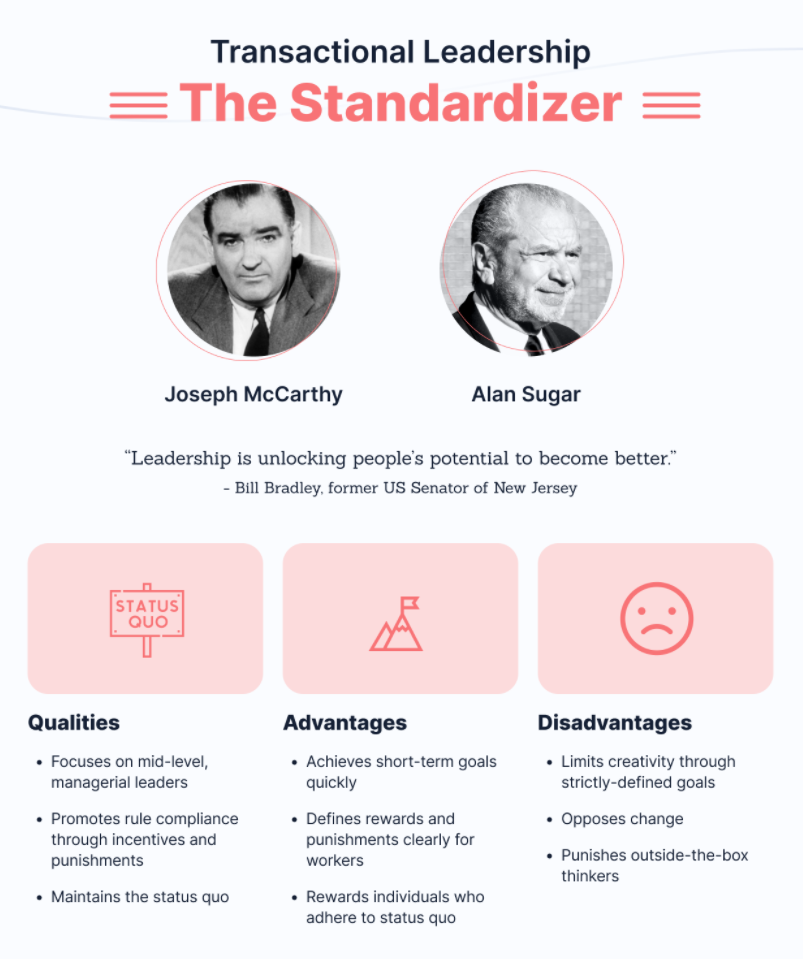
Transactional leadership is based upon establishing a status quo, rewarding those who participate in it, and punishing those who don’t. The aim of transactional leadership is to establish regularity and consistency through that reward-punishment paradigm, and it’s worked for a lot of different leaders. The style tends to focus on managers, people who can enforce the status quo, and promotes following the rules.
The ultimate goal is to establish a status quo that works and protect it, similar to bureaucracy. However, unlike bureaucracy, the status quo of transactional leadership can relate to personal standards, beliefs, and other highly-personal traits.
Ultimately, transactional leadership achieves short-term goals quickly. It also lays out rewards and punishments clearly, and rewards those who follow the status quo the most.
But transactional leadership also limits creativity because of its strict rules and regulations. That also makes it oppose change, and it can punish outside-the-box thinkers who want to shake things up. Senator Joseph McCarthy is one of America’s most famous transactional leaders.
During his time in office, he was the heart of the communist panic in the United States, and he accused countless public figures of associations with communism.
That accusation may not carry a lot of weight today, but it did during the Cold War. Just like the Salem Witch Trials, an accusation that you were a communist was enough to blacklist you and keep you from living a normal American life. In this scenario, McCarthy established the status quo for most of the United States, and those who deviated from his strict definitions of democracy and capitalism were publicly punished.
In the corporate world, Alan Sugar (AKA “Lord Sugar”) is well-known for setting strict rules in his companies. His strategy has turned him into a business magnate, reality TV star, and author.
His company — Amstrad — is a leading British electronics company that he founded in 1968. It’s somewhat small with only 85 employees as of 2005, but it earns millions every year.
Style #8. Transformational leadership: The inspirer
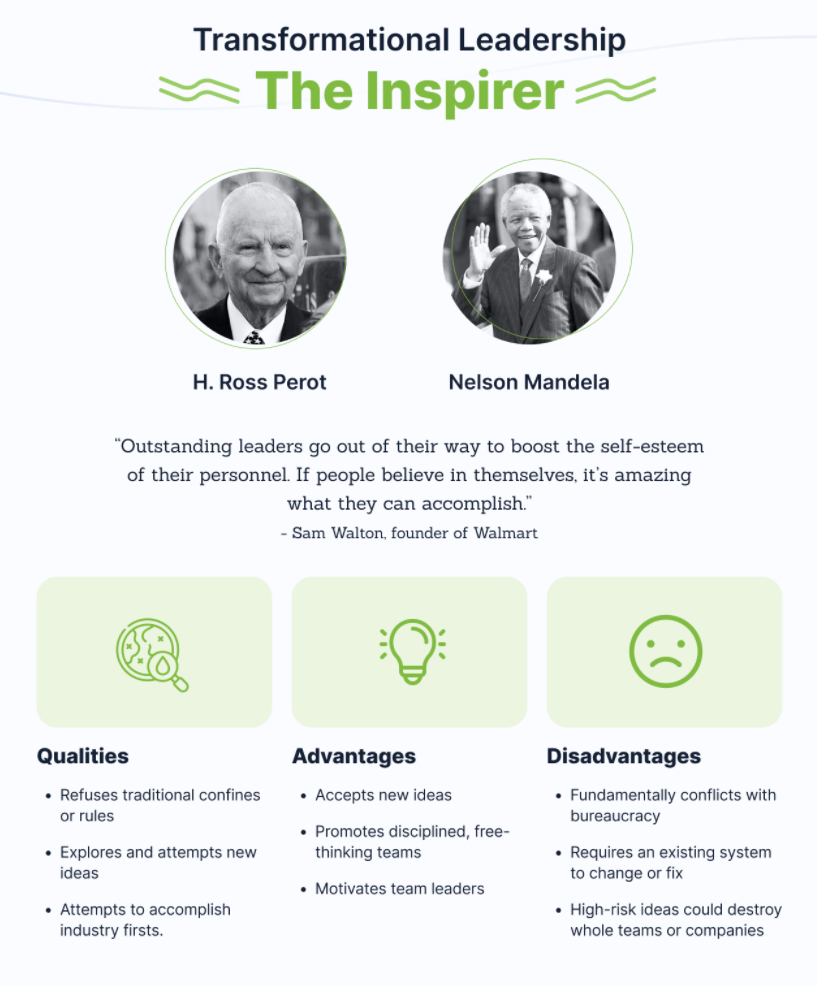
Finally, we have transformational leadership, which aims to inspire its followers. Transformational leadership is similar to servant leadership in that it refuses established confines or rules. As a result, it seeks out new ideas instead.
Organizations that operate under this style shoot to be the first to do something major in their industries.
That means transformational leadership accepts new ideas readily. It also promotes disciplined and free-thinking teams, all of which are managed by a motivated, focused team leader. Unfortunately, transformational leadership has some major drawbacks.
For one, its natural refusal of established standards means it conflicts directly with other leadership styles, especially bureaucracy. And, like servant leadership, it requires an existing system to change or fix. Finally — and most dangerously — high-risk ideas have the potential to destroy organizations if they fail.
And because transformational leadership is based on new ideas, there will certainly be a few that flop.
H. Ross Perot, who many may remember for his 1996 presidential campaign, is a transformational leader. Perot founded a business called Electric Data Systems that serviced computers developed by other companies.
He gave permission to his field technicians to do whatever they had to do to please the customer, which sometimes meant going above and beyond.
With a predilection toward excellence and a growing base of happy customers, Perot’s company thrived under his slogan: “Go, do.” Nelson Mandela is another transformational leader, but for very different reasons. Mandela rose to prominence in his opposition to apartheid — institutionalized racism — in South Africa. Rallying against that paradigm, Mandela became a prominent figure and, eventually, president.
His personality and administration threw out the old ideas of disenfranchisement and instead embraced compassion, generosity, and togetherness.
He suffered for his cause before becoming president, living 27 years of his life as a political prisoner, and became an icon for forgiveness in a country torn to shreds in anger.
-
 The WebFX team is made up of more than 450 subject matter experts in digital marketing, SEO, web design and web development, social media, and more. Together, they’ve helped WebFX’s clients earn more than $3 billion in revenue from the web — and that’s just in the past five years.@webfx
The WebFX team is made up of more than 450 subject matter experts in digital marketing, SEO, web design and web development, social media, and more. Together, they’ve helped WebFX’s clients earn more than $3 billion in revenue from the web — and that’s just in the past five years.@webfx -

WebFX is a full-service marketing agency with 1,100+ client reviews and a 4.9-star rating on Clutch! Find out how our expert team and revenue-accelerating tech can drive results for you! Learn more
The Internet in Real Time
Ever wonder how much is going on at once on the Internet? It can be tough to wrap your mind around it, but we’ve put together a nice visual that’ll help! The numbers show no sign of slowing down either.
Find out More
Table of Contents
- Style #1. Autocratic Leadership: the Commander
- Style #2. Bureaucratic Leadership: the Administrator
- Style #3. Charismatic Leadership: the Charmer
- Style #4. Democratic Leadership: the Motivator
- Style #5. Laissez-Faire Leadership: the Delegator
- Style #6. Servant Leadership: the Steward
- Style #7. Transactional Leadership: the Standardizer
- Style #8. Transformational Leadership: the Inspirer

Ready to Drive Results for Your Business?
See how WebFX uses SEO, PPC, Social Media, and Web Design to Drive Revenue for Businesses.
Get InspiredThe Internet in Real Time
Ever wonder how much is going on at once on the Internet? It can be tough to wrap your mind around it, but we’ve put together a nice visual that’ll help! The numbers show no sign of slowing down either.
Find out More





